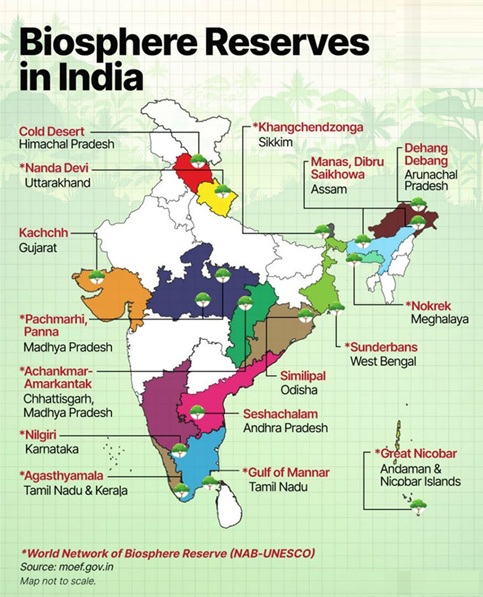(Preliminary Exam: Environment and Ecology)
(Mains Exam, General Studies Paper 3: Environmental Protection, Biodiversity, Environmental Impact Assessment) |
Context
Recently, Himachal Pradesh's Cold Desert Biosphere Reserve was included in UNESCO's World Network of Biosphere Reserves (WNBR) list. With this, India now has 13 biosphere reserves listed in this international network.

About the Cold Desert Biosphere Reserve
- It is India's first high-altitude Cold Desert Biosphere Reserve.
- The reserve covers an area of approximately 7,770 square km.
- It is divided into three parts:
- Core Zone: 2,665 square km.
- Buffer Zone: 3,977 sq km
- Transition Zone: 1,128 sq km
Areas Covered
- It is located in the Trans-Himalayan region and includes the Lahaul-Spiti district.
- It includes the Spiti Wildlife Division, Lahaul Forest Division, Baralacha Pass, Bharatpur, and Sarchu.
- Its elevation ranges from 3,300 meters to 6,600 meters.
- The region includes the Pin Valley National Park, Kibber Wildlife Sanctuary, Chandratal Wetland, and Sarchu Plains.
Fauna and Flora
- 17 mammal species and 119 bird species are found here.
- The main attraction is the snow leopard, which is considered the flagship species here.
- The Himalayan ibex and Himalayan wolf are also found here.
- It is home to 655 medicinal herbs, 41 shrub species, and 17 tree species, many of which are endemic and of medicinal importance.

Significance
- The reserve protects India's rare mountain ecosystem.
- It is also associated with cultural heritage, with approximately 12,000 residents practicing traditional animal husbandry, barley and pea cultivation, and Tibetan medicine (Sowa Rigpa).
- The region is governed by the traditions of Buddhist monasteries and community councils, which collaborate to conserve natural resources.
UNESCO Recognition
- This international recognition places the region on the global conservation map.
- It will promote research collaborations, sustainable tourism, and climate resilience.
- It demonstrates India's commitment to biodiversity conservation and community development.
Conclusion
The inclusion of Himachal's Cold Desert Biosphere Reserve in the UNESCO list is a significant achievement for global environmental protection. This step is not only essential for the enhancement of the Himalayan ecosystem but also safeguards the traditions and livelihoods of local communities. This is another example for India that development and conservation can go hand in hand.



